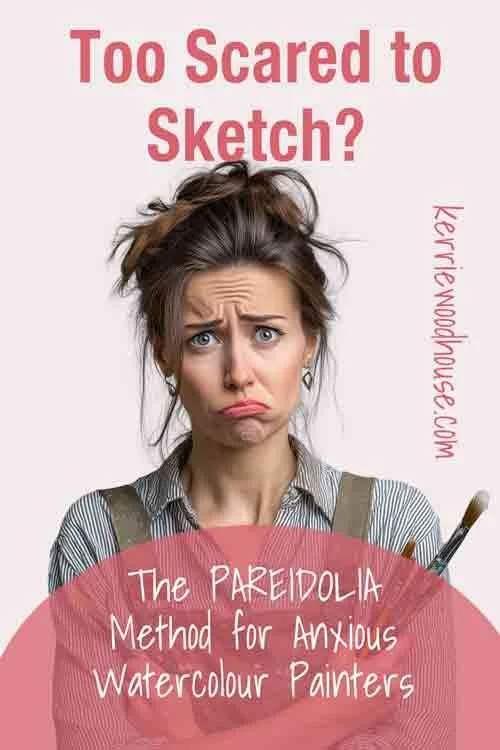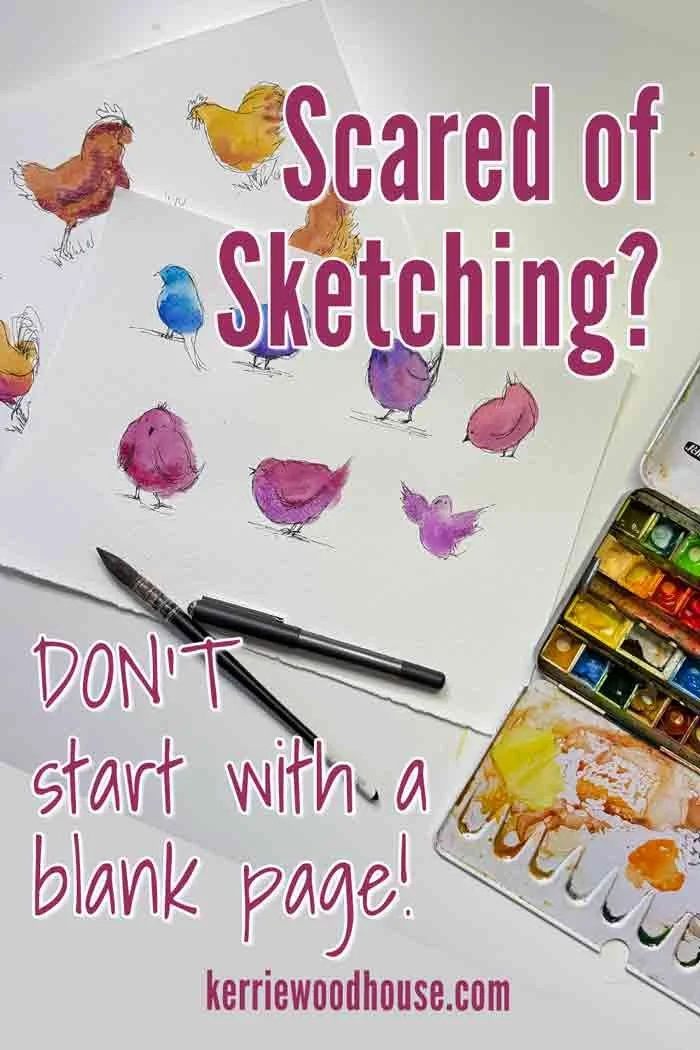Too Scared to Sketch? The Pareidolia Method for Anxious Watercolour Painters
Does that blank page stare back at you like an intimidating white void? Do you find yourself procrastinating on sketching because you're worried about making the "wrong" mark? If you're nodding along, you're definitely not alone.
So let’s see what we can do about that right now.
The fear of that pristine white surface has stopped countless watercolor artists from picking up their brush.
But guess what?
You don't actually have to start with a blank page if you don't want to. In fact, there's a delightfully liberating technique that turns this problem on its head, and it's based on something your brain is already wired to do naturally.
What Is the Pareidolia Method?
Pareidolia is that wonderful human tendency to see faces in clouds, animals in rock formations, or even a grumpy expression in your electrical outlet. Your brain is naturally wired to recognise patterns and find familiar shapes in random forms. For watercolour artists, this isn't just a quirky brain function—it's your artistic superpower.
The pareidolia method harnesses this natural ability by starting with spontaneous colour blobs and then using your pattern-recognition skills to discover the art hidden within them. It's like having a conversation with your painting where each mark you make gives you something to respond to with the next mark.
Why This Method Works So Well for Watercolour Artists
Traditional drawing often starts with careful planning and precise lines, which can feel overwhelming when you're staring at that blank page. The pareidolia method flips this approach entirely:
Removes the pressure of perfection - You're not trying to create something specific from the start
Engages your playful, creative side - You're literally playing with color and discovering what emerges
Builds confidence gradually - Each small decision leads naturally to the next
Celebrates happy accidents - Those unexpected color bleeds become features, not mistakes
Makes the most of watercolor's strengths - You're working with the medium's natural flow and unpredictability
The Step-by-Step Pareidolia Process
Step 1: Splash in Joyful Color
Start by choosing any colour that calls to you in the moment and placing a blob on your page. Don't overthink this—go with your gut. As you place each blob, you're:
Getting familiar with how your brush behaves on the paper
Experimenting with different brush angles and pressure
Discovering which colours you're drawn to today
Enjoying the magic of wet-into-wet colour mixing
Try creating shapes that roughly resemble jelly beans, eggs, or simple organic forms. These work particularly well because they're already suggestive of living creatures.
Step 2: Let Your Imagination Wander
While you're painting these colourful shapes, your brain is already starting to work its pattern-recognition magic. You might notice that one blob looks like it could be a bird, another resembles a fish, or perhaps you see the makings of a flower.
Don't force it—just stay open to what emerges. Sometimes adding a small flick of color (which could become a tail) or an extra blob (perhaps a head) can help guide the direction.
Step 3: Let Everything Dry Completely
This is crucial. You need your painted shapes to be completely dry before moving to the next step, or you'll risk damaging your paper and ruining your pen.
Step 4: Discover Your Hidden Art
Once dry, grab a pen—waterproof is ideal, though since you've already done your painting, any pen will work. This is where the real magic happens.
Look at your shapes and let your brain do what it does best: find patterns. It might take a moment for your eye to tune in, just like when you're cloud-watching. But once you start seeing possibilities, the ideas will flow.
Want to see what I mean? 🍿
From Abstract to Recognisable: Making Your Marks Count
The beauty of this method is that you don't have to stick rigidly to the painted shapes. If you see a bird but want to add a tail that extends beyond the original blob, go for it! The colour was just your starting point—your jumping-off place into creativity.
When adding your pen marks, consider:
Eyes and beaks - As I often say, almost any shape starts to look like a bird once you give it an eye and a beak
Characteristic features - A rooster's comb, a chicken's wattle, or decorative elements that bring personality
Expressive lines - Don't just draw what you see; capture the character and energy of your subject
Broken outlines - Rather than solid outlines, try using sections of line that suggest the form while keeping things loose and lively
Taking It Further: Reference-Based Pareidolia
Once you're comfortable with purely imaginative shapes, you can apply this method to working from reference photos. Instead of random blobs, you're painting loose silhouettes of your subject—still keeping things spontaneous and free, but with a gentle direction toward your intended subject.
This approach is particularly effective for subjects like birds, where you can capture the essence of the pose and proportion without getting bogged down in details from the start.
Why This Method Builds Long-Term Confidence
The pareidolia method isn't just about creating individual pieces—it's about building a fundamental trust in your artistic instincts. Each time you successfully transform a blob into something recognisable, you're proving to yourself that you can find creative solutions and that your artistic voice has value.
This confidence carries over into all your other watercolour work. You start to see that "mistakes" can become opportunities, that spontaneity can lead to beautiful discoveries, and that the journey of creating art can be just as rewarding as the final result.
Beyond the Blank Page: A New Way to Begin
The most liberating aspect of this method is that it completely reframes how you approach the creative process. Instead of needing to have everything figured out before you begin, you're entering into a collaboration with your materials and your intuition.
Every mark on the page becomes something to respond to, turning the creative process into something like a game. It's creativity in action—spontaneous, responsive, and deeply satisfying.
It is also very much easier to work where the ‘right’ lines and angles should be in your drawing when you have a preliminary line or angle already on the page to work with. It’s a bit like when they pass around the birthday card in the office for everyone to sign. No one wants to go first! But when the first brave soul has put their birthday sentiment in, it gives everyone else a much easier starting point. Now its easier to write something… similar… but hopefully better!
That’s what the blob is. A starting point from which you can choose to keep the outline as it is or make little adjustments to improve it.
Ready to Try the Pareidolia Method?
Remember, there's no right or wrong way to do this. We all see different shapes in the same blobs, and that's exactly what makes this method so personal and rewarding. Whether you're painting from imagination or working toward reference photos, free yourself from any preconceived ideas about how things "should" turn out.
The goal isn't perfection—it's play, discovery, and building confidence one colourful blob at a time.
Love the idea of painting chickens in watercolour?
Of course you do! They are a delightful subject to paint.
Come and join us 👇
Are you on your own painting journey?
One of these might be useful…










